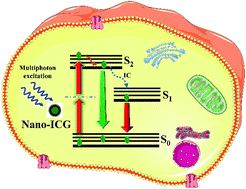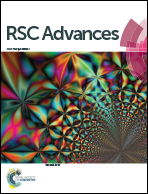The effect of nanoencapsulation of ICG on two-photon bioimaging†
Abstract
Multiphoton imaging, a highly effective diagnostic technique, has recently gained widespread attention for early-stage cancer detection. Tremendous efforts have been dedicated to explore various types of exogenous contrast agents for improved signal-to-noise ratio of multiphoton imaging. Indocyanine green (ICG), the only U. S. FDA approved near-infrared chromophore, has been recently used as an exogenous contrast agent for two-photon bioimaging. Despite its great potential applications in clinical settings, the conventional delivery method of ICG has limited applications due to its poor cellular uptake and optical stability in its free form. Herein, we report the effect of nanoencapsulation of ICG on two-photon bioimaging. For this study, ICG was encapsulated within poly-L-arginine (PLA) based nanoparticles for the first time. These nanoparticles were found to be biocompatible and biodegradable as the major constituents were salts and PLA. These nanoparticles were spherical with a mean diameter of ∼61 nm and exhibit higher photostability than free ICG. Additionally, nanoencapsulated ICG treated cells show enhanced contrast for two-photon bioimaging in comparison with its free form. In summary, nanoencapsulated ICG could serve as an exogenous chromophore for multiphoton imaging, which shows excellent delivery efficacy.



 Please wait while we load your content...
Please wait while we load your content...